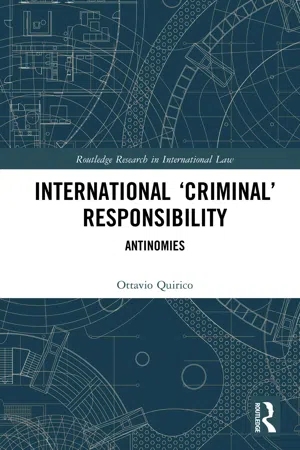1.1.1 The dawn of criminal responsibility in international law: proposals for a universal criminal code (1860–1919)
The first proposal for an international criminal court goes back to Gustave Moynier, President of the International Committee of the Red Cross (ICRC). Moynier suggested the establishment of an international criminal jurisdiction to adjudicate upon and prevent breaches of the 1864 Geneva Convention for the Amelioration of the Condition of the Wounded in Armies in the Field6.Different initiatives followed at the beginning of the 20th century, aiming to define a system for international criminal law from the standpoint of both substance and procedure. Notably, Moynier’s proposal is part of the progressive codification of the rules on the peaceful settlement of international disputes and the regulation of the law of war via the Hague Conventions of 1899 and 19077,which built upon core regulation embedded in the 1964 Geneva Convention. These projects constitute the background for codification developed after World Wars I and II.
After the end of World War I, on 25 January 1919 the Paris Peace Conference held in Versailles established a Commission to assess the responsibility of individuals allegedly accountable for the facts that took place during the war. The Commission submitted a Report envisaging the establishment of an international criminal tribunal8. As a follow-up, the Conference adopted Article 227 of the Versailles Treaty,9 which arraigned William II of Hohenzollern, former German Emperor, for waging war as ‘a supreme offence against international morality and the sanctity of treaties’10. A ‘special tribunal’, comprising five judges appointed by the United States (US), Great Britain, France, Italy and Japan, had jurisdiction over the offence. By contrast, Articles 228 and 229 established the trial of other war criminals by military tribunals of the Allied and Associated Powers. According to Hans Kelsen, the acceptance of such provisions by Germany signified recognition of individual criminal responsibility for acts of State11. However, the Netherlands refused to extradite the Emperor and Germany refused to surrender officials accused of war crimes. The Allied Powers therefore agreed to the officers being judged by the Supreme Court of Leipzig, so as not to destabilise the newly established Republic of Weimar. The Court only convicted twelve officers with light sentences.12
A bilateral approach to invocation of State responsibility characterises this historical period, based on the principle of reparation. However, some scholars suggested the establishment of an aggravated regime of responsibility, whereby breaches of erga omnes obligations were supposed to trigger collective State reaction and aggravated sanctions, including adequate satisfaction, fines and assurances of non-repetition13.In this respect, the Treaty of Versailles imposed on Germany sanctions under Articles 159–213 that some scholars considered to be mainly aimed at punishing State criminality, notably for aggressive war, for instance, the obligations to demobilise and reduce armed forces under Article 15914.Furthermore, Articles 11 and 16 of the Covenant of the League of Nations qualified war as an erga omnes breach, affecting ‘the whole League’ and entailing specific sanctions, such as the severance of financial and trade relations. The Council of the League was mandated to coordinate the collective enforcement of these sanctions.
1.1.2 Interwar coordination (1920–1939)
1.1.2.1 Triggering initiatives within the League of Nations
Following the experience of World War I, different initiatives were undertaken within and outside the League of Nations in order to establish a system of international criminal law. Within the context of its work on the establishment of a PCIJ under Article 14 of the Covenant of the League, an Advisory Committee of Jurists put forward a first project. In 1920, the President of the Committee proposed the adoption of a Recommendation to the Council and the General Assembly of the League on the institution of a High Court of International Justice. This would have had competence ‘for the purpose of trying crimes against international public order, and against the universal law of nations’ (Article 3)15. The Court could adjudicate upon a referral by the Assembly or Council of the League of Nations (Article 4).
Article 3
The High Court of Justice shall be competent to try crimes constituting a breach of international public order or against the universal law of nations, referred to it by the Assembly or by the Council of the League of Nations.
Article 4
The Court shall have the power to define the nature of the crime, to fix the penalty and to decide the appropriate means of carrying out the sentence.
More generally, the possibility was envisaged of establishing the compulsory competence of the PCIJ after exhaustion of diplomatic means16, which was nonetheless eventually abandoned in favour of consensual jurisdiction under Article 36 of the PCIJ Statute. This approach followed critiques by France and the United Kingdom (UK), which considered it dangerous to allow States to act unilaterally in court against one another.Eventually17, the Council and Assembly of the League of Nations decided that the question of State criminal responsibility was not ready for definition and submitted it to the attention of institutions specialised in international law in view of a Conference on the topic18.
Later proposals suggested the institution of an international criminal court with competence over both individual and State responsibility, as well as the responsibility of other legal persons19. In 1923, the Draft Treaty on Mutual Assistance prepared by the Commission on Armaments of the League of Nations qualified war as a ‘State crime’ and envisaged collective countermeasures20. The Treaty, however, never entered into force. In 1924, the Fifth Assembly of the League of Nations adopted the Geneva Protocol for the Pacific Settlement of International Dispute...
